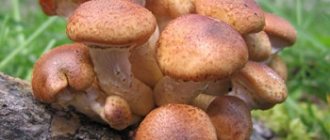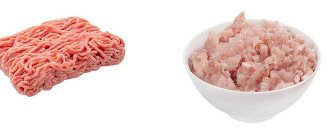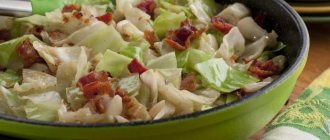Properties are oily
Nutritional value and composition | Vitamins | Minerals
How much does boletus cost (average price for 1 kg)?
Moscow and Moscow region.
500 rub.
In terms of their nutritional qualities, these mushrooms belong to the second category, but when assessing the beneficial properties of boletus, connoisseurs place them at the same level, and sometimes even higher, than boletus mushrooms. They reach a height of eight centimeters and are distinguished by a yellow-red, honey or dark brown cap. When cut, the flesh of the mushroom is yellow in color, which does not fade even with time. When you go “hunt” for these beauties, don’t forget to look under the fallen leaves or pine needles, because that’s where they hide, forming barely noticeable tubercles.
You can prepare any mushroom dish from tasty and fragrant butter, but remember that before boiling or pickling, you just need to remove the skin. It promotes blackening of the caps and thickens the marinade, which makes the incomparable dish unattractive.
If you decide to simply fry or dry the mushrooms, use them with the skins intact, as they darken during heat treatment. When dry, boletus crumbles easily, which many cooks happily take advantage of by adding them to pureed soups and sauces. Among other things, these mushrooms are included in various multi-ingredient dishes, such as stews, stews and salads.
Application
The taste properties of boletus resemble porcini mushrooms. After collecting the mushrooms, the legs are cleaned of sand, and the cap must be cleared of the oily skin. You don’t need to remove the film from young mushrooms.
These mushrooms are fried, added to sauces and purees, and used as a side dish. But the most delicious are salted and pickled butter. Before marinating, be sure to boil them twice for 10 minutes in salted water. To prevent the brine from darkening, you need to add a few grains of citric acid. Ingredients of the marinade: 0.5 liters of water, 1 tablespoon each of salt and 9% vinegar, 1.5 tbsp. spoons of sugar. Boil the marinade, pour into a jar with mushrooms and roll up. If you add some pickled mushrooms to a regular salad consisting of potatoes, eggs, chicken, and green peas, then such a dish will decorate the festive table.
Market Analytics
- COVID-19 is changing the rules of the game in the cosmetics market
- Beauty of the future: cosmetic innovations 2020
- New ingredients are the driving force of the cosmetics industry
Convenient search for beauty salons on our website
Beauty salons in Moscow Beauty salons in St. Petersburg Beauty salons in Ekaterinburg Beauty salons in Novosibirsk
Latest blog posts on our website
- Naturecream / Geranium (Pelargonium) oil for skin health and beauty
- Prostye-sovety / Save on a beauty salon: procedures that can be done at home
- Naturecream / Growth Factor - brings back youth?
- Oksana-Lezina / 3 effective abdominal exercises from a fitness instructor for beginners
- Prostye-sovety / Making perfect curls at home
- Prostye-sovety / Which hair removal method to choose
- Naturecream / Wrinkles Puppets
- Naturecream / PEPHA-TIGHT - instant skin lifting
- Naturecream / Blue light - a danger to the skin
- Naturecream / Cocoa Butter – A treat for the skin
Latest forum topics on our website
- Mrs._Smith / Badly sunburned! What to do?((
- Ice / Is it necessary to combine fitness classes with a diet?
- Antonova / What can be used for hair loss?
- Radio operatorKat / Who was on a protein diet?
- Suzanna / Mesotherapy on the face
Other articles in this section
| Truffles Truffles are marsupial mushrooms that grow underground and have fleshy bodies. They are an edible delicacy. The most valuable variety of this mushroom is the Italian winter truffle. They are widespread in the south of France and the north of Italy in luxurious groves, mainly oak and beech. Truffles also grow in Russia, where they are called summer truffles. These mushrooms have a specific taste, which is similar to the taste of roasted seeds or walnuts. They also have a strong aroma. If you taste the water in which these mushrooms were boiled, it will taste like soy sauce. |
| White dried White mushrooms belong to the boletus genus. They gained wide popularity due to their unique taste qualities, which are definitely superior to all other edible mushrooms. Why this species is called “white” is unknown, but already in the dictionary of V.I. Dalia mushroom has this name. When storing dried porcini mushrooms, it is worth considering that they perfectly absorb moisture, so the premises for storing them must be clean, dry, with constant air circulation and without sudden temperature changes. |
| Oyster mushrooms Oyster mushrooms are a common, accessible and inexpensive product. They grow on trees and stumps, grown on straw and sawdust thanks to modern technologies for their production, which were developed by German mushroom growers during the First World War. This mushroom can be grown fairly quickly and is also easy to process. This mushroom is easy to grow at home. The surface of the mushroom cap is smooth, wavy, and various shades of gray. |
| Morels The morel is a conditionally edible mushroom of the morel family. It is most often light brown in color and its body is filled with pores. Morels appear earlier than any other mushrooms - as soon as the snow begins to melt. This mushroom has an oval cap with an uneven surface, which is somewhat reminiscent of a walnut. The color of the morel stem is white, while it is smooth and breaks easily. The flesh of this mushroom is also white in color and has a pleasant aroma. |
| Boletus One of the tasty and valuable mushrooms for cooks is the boletus from the genus Leccinum. The mushroom cap is spongy, similar in color to an aspen leaf: from light yellow to dark brown, the body is dense. Grows in mixed and deciduous forests. The optimal harvest time is in August - September. |
| Puffballs The puffball mushroom can be found in deciduous and coniferous forests, sometimes on rotting wood or on the soil. The mushroom has a closed, rounded fruiting body up to 8 cm in diameter, with a pseudopod up to 3 cm thick. The skin of the puffball is covered with small pearl-like growths that fall off when ripe. Young specimens have a uniform consistency, bright white skin and pulp, which changes to gray and then brownish-brown as the mushroom ages. Mature mushrooms become inedible; secrete brown-brown spores through the apex; their flesh is less elastic than the flesh of young mushrooms. |
| White pickled White mushroom is so called due to its property of not changing color when cooked. Since ancient times, this mushroom has been considered noble; it is called the “king of mushrooms.” The porcini mushroom grows in old pine and spruce (for this it is also called boletus), oak and birch forests. Very common in Russian forests. It grows singly and in groups from the second half of July until late autumn. |
| Chanterelles Chanterelle mushrooms (also known as forest chanterelle, common chanterelle, fox, cockerel, sploen) can be found in coniferous or mixed forests. The mushroom got its name due to its bright yellow or orange color. Mushrooms grow in large groups, especially in rainy weather, from July to late autumn. Chanterelles have a peculiar structure. Raw mushrooms do not break or crumble, so you don’t have to worry about damaging them when picking them. |
| Gruzdi The word “gruzd”, as you know, comes from the Old Slavonic word “gruzdie” (heap). This mushroom is called so because it grows in heaps and families. According to another version, it received this name for its massiveness and heaviness. The milk mushroom belongs to the Syroezhkov family. Grows in deciduous and mixed forests. It is common in central Europe and Asia. However, in Western European countries it is almost unknown and is considered inedible. At the same time, in Russia, especially in Siberia, it has long been considered the best for pickling. Milk mushrooms contain caustic juice in their pulp, which loses its causticity when processed. They have a strong specific smell. The time for collecting milk mushrooms is August, September. |
| Dried chanterelles The common chanterelle got its name due to its bright yellow-orange color, which is very similar to a fox. In addition to this type, there are others that are not very common: velvety, gray and faceted. In the classification valid for Western Europe, these mushrooms are classified in the first category, which includes the most valuable edible mushrooms. |
Benefits of butter
The calorie content of butter is 19.2 kcal, while they are rich in vitamins B2, B6, contain amino acids, fiber, fatty acids, as well as lecithin, which prevents the deposition of cholesterol. All this undoubtedly speaks in favor of butter.
As a result of scientific research, scientists have found that some types of oil contain a rare resinous compound that helps relieve acute headaches and accelerates the excretion of uric acid in gout.
Almost all the components contained in these mushrooms are easily absorbed by the human body. To prove the benefits of boletus, it should be noted that they, like all mushrooms, have a general strengthening effect on the body and help prevent colds.
Beneficial features
It has been established that all the beneficial substances found in boletus mushrooms are absorbed 100%, so the use of these mushrooms helps prevent colds and also has a general strengthening effect on the body. The resinous substance contained in boletus has been proven to help relieve headaches and promote the elimination of uric acid in gout. But it should be borne in mind that these mushrooms tend to accumulate radioactive elements, so you cannot collect them near industrial enterprises. It is recommended to boil boletus twice in water before cooking, even if it was collected from the forest. They also contain a substance - chitin, which interferes with the absorption of food, so butter is not recommended for patients with diseases of the gastrointestinal tract.
Harm is oiled
Scientists from the Institute of Biophysics, Siberian Branch of the Russian Academy of Sciences, after numerous studies, have established the fact that boletus is harmful. It turned out that of the 12 varieties of mushrooms that grow near industrial enterprises, these mushrooms are recognized as the most harmful. The fact is that boletus is capable of accumulating the most dangerous and radioactive chemical element - cesium. Therefore, when collecting these mushrooms, try to avoid such places.
In addition to the above, it is worth mentioning one more argument regarding the harm of butter. The fiber contained in these mushrooms is saturated with chitin, and this interferes with the process of normal digestion and absorption of food. Doctors do not recommend this type of mushroom for chronic diseases of the gastrointestinal tract and digestive disorders.
Butter: benefits and harm
The beneficial properties of these mushrooms are very diverse. Many people believe that the nutritional quality of butter mushrooms is higher than that of porcini mushrooms. In terms of nutritional value, by the way, they are not inferior to them.
Young boletus has more protein than old one.
These mushrooms contain trace elements and vitamins. In terms of vitamin B content, boletus is not inferior to grain crops, as well as butter. If we talk about vitamin PP, then they contain exactly as much as in liver and fish.
Let's talk about proteins... In terms of their content in dried mushrooms, they are twice as much as in beef meat, and also 3 times more than in fish.
The bad thing is that buttered protein is less digestible. To fix this, you need to chop the mushrooms well and subject them to long-term heat treatment.
We have described boletus mushrooms, the benefits and harms of which are not comparable in percentage terms. Above we described the beneficial properties. Now let’s look at how these fungi can harm our body.
Due to the structure of the cap, these mushrooms accumulate various substances that come from the atmosphere. Therefore, you should not collect them near roads and in places with unfavorable environmental conditions, as this is dangerous.
Butter is difficult to digest, so it is not recommended to eat them for those who have stomach upsets and gastrointestinal diseases.
In order for mushrooms to be better absorbed in the body, they need to be cooked for a long time, and they need to be cut finely.
Butter is perishable, they need to be processed very quickly and cannot be stored for a long time. Before use, soak and boil to neutralize radioactivity and toxicity. Boiled boletus can be stored in the refrigerator for a long time.
Contraindications and possible harm oily
Oilseeds tend to absorb and accumulate heavy metals: lead, cesium, and radioactive nuclides. Completely normal-looking mushrooms can cause serious intoxication. You cannot collect in an industrial zone near factories or on the sides of federal highways. Gas contamination makes mushrooms unsuitable for consumption.
Due to the content of chitin, the absorption of mushroom protein is worse than that of animal protein. No matter how beneficial properties boletus may have, there are also contraindications for consumption, even of mushrooms collected in an environmentally friendly area. Limit use to people suffering from:
- allergies to mushrooms;
- metabolic disorders;
- with dysfunction of the digestive system, mushrooms can cause indigestion;
- pickled boletus is not indicated for hypertensive patients;
- with exacerbation of gastritis;
- low or high acidity;
- diseases of the pancreas.
It is not recommended to include boletus in the diet of pregnant women and children under 3 years of age.
Nutritional value per 100 grams
Mushrooms in this quantity contain 90% water. The other 10% is distributed as follows: 4% - proteins, 2% - fiber, 1.5% - carbohydrates, 1% - fats, 1.5% - minerals.
The nutritional value of these mushrooms is not inferior to that of white mushrooms. The digestibility of protein in them is up to 80%. They contain vitamins A and C, PP and B vitamins. Microelements in boletus are iron and potassium, zinc and phosphorus, copper and iodine. Recently, a resinous compound was discovered in them that can relieve headaches.
Calorie content
The calorie content of a hundred gram portion of the product is 17-19 kilocalories. Culinary processing increases the energy value of dishes prepared from them. So, fried boletus contains up to 60 kilocalories per hundred grams, stewed - 45-50 kcal.








